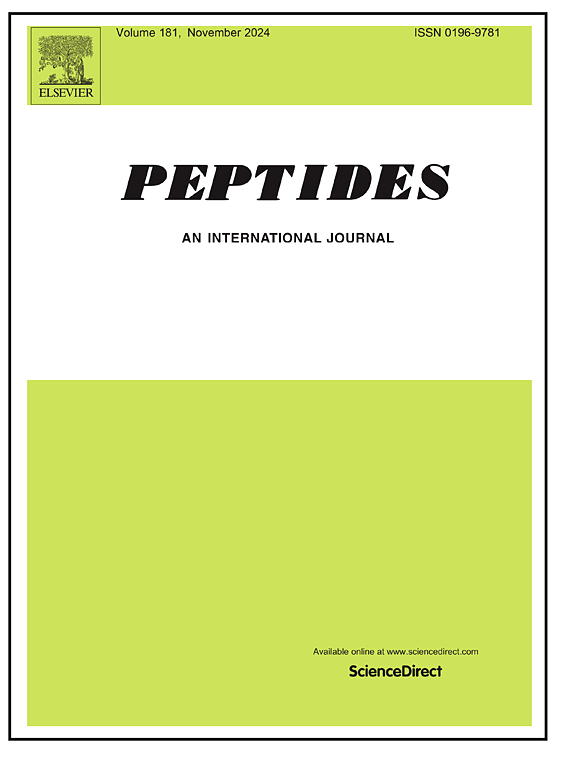调节肽26RFa在雌雄小鼠体内的全身分布。
IF 2.9
4区 医学
Q3 BIOCHEMISTRY & MOLECULAR BIOLOGY
引用次数: 0
摘要
26RFa是一种最初从大脑中分离出来的调节肽。rfa被发现参与了一些重要功能的调节,如能量和葡萄糖代谢的调节。然而,26RFa在生物体器官/组织中的整体分布仍然是零碎的,尽管它代表了发现这种调节肽的新生理功能的关键一步。为此,我们在表达26rfa的细胞中产生了表达荧光蛋白tdTomato的小鼠细胞系,并使用三维成像方法可视化tdTomato在toto中的免疫染色。结果表明,26RFa主要分布于雌雄小鼠体内。在中枢神经系统的许多区域,包括嗅球、皮质、海马体、下丘脑、小脑、脑干和脊髓,都发现了表达rfa的细胞。在外周,沿胃肠道、肝脏、白色脂肪组织、肾脏、肾上腺、肺、男性和女性生殖道、横条肌、胸腺以及一些外分泌腺(如唾液腺、前列腺、精囊)均检测到表达26rfa的结构。总之,目前的解剖观察结果与先前报道的26RFa的主要生理功能一致,如调节能量和葡萄糖代谢或控制下丘脑-垂体-性腺或肾上腺轴。然而,26RFa存在于其他器官/组织中,其生理相关性完全未知,因此为这种调节肽开辟了一个新的研究领域。本文章由计算机程序翻译,如有差异,请以英文原文为准。

Whole body distribution of the regulatory peptide 26RFa in male and female mice
26RFa is a regulatory peptide initially isolated from the brain. 26RFa was found to be involved in the regulation of vital functions such as the regulation of energy and glucose metabolism. However, the whole distribution of 26RFa in the organs/tissues of the organism remains fragmentary although it represents a crucial step to discover novel physiological functions for this regulatory peptide. To this aim, we have generated a mouse line that expresses the fluorescent protein tdTomato in 26RFa-expressing cells, and visualization of tdTomato immunostaining in toto was performed using the tridimensional imaging approach.
Our observations reveal that 26RFa is largely distributed among the organism of male and female mice. 26RFa-expressing cells were notably found in numerous regions of the central nervous system including the olfactory bulbs, the cortex, the hippocampus, the hypothalamus, the cerebellum, the brainstem and the spinal cord. At the periphery, 26RFa-expressing structures were detected all along the gastrointestinal tract, in the liver, the white adipose tissue, the kidney, the adrenal gland, the lungs, the male and female reproductive tracts, the striated muscles, the thymus and a number of exocrine glands such as the salivary glands, the prostate, the seminal vesicles.
In conclusion, the present anatomical observations are in agreement with the main physiological functions previously reported for 26RFa such the regulation of energy and glucose metabolism or the control of the hypothalamo-pituitary-gonadal or adrenal axis. However, 26RFa is present in other organs/tissues in which its physiological relevance is totally unknown opening therefore a new field of research for this regulatory peptide.
求助全文
通过发布文献求助,成功后即可免费获取论文全文。
去求助
来源期刊

Peptides
医学-生化与分子生物学
CiteScore
6.40
自引率
6.70%
发文量
130
审稿时长
28 days
期刊介绍:
Peptides is an international journal presenting original contributions on the biochemistry, physiology and pharmacology of biological active peptides, as well as their functions that relate to gastroenterology, endocrinology, and behavioral effects.
Peptides emphasizes all aspects of high profile peptide research in mammals and non-mammalian vertebrates. Special consideration can be given to plants and invertebrates. Submission of articles with clinical relevance is particularly encouraged.
 求助内容:
求助内容: 应助结果提醒方式:
应助结果提醒方式:


